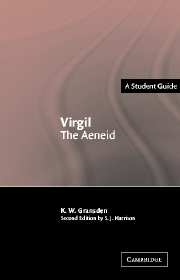2 - Virgil and Homer
Published online by Cambridge University Press: 05 June 2012
Summary
‘Arms and the man’
Other Latin poets before Virgil had written important large-scale hexameter compositions. Lucretius' great didactic epic De Rerum Natura (‘on the nature of things’) was an exposition of the physical universe according to the doctrine of Epicurus: although Virgil reacted against its materialism, he was much indebted to Lucretius' style and technique. Earlier, Quintus Ennius (239–169 bc) had written heroic narrative epic, proudly claiming to be a reincarnation of Homer. His Annales, as their name implies, was a chronological record of the story of Rome from the fall of Troy (Virgil's starting-point too, though his treatment is not chronological) to the death of Romulus. There were eighteen books, unfinished at their author's death, of which only fragments survive, but enough to show that Virgil often echoes the grand cadences and phrases of his predecessor.
But in composing the Aeneid Virgil deliberately departed from the annalistic tradition. His masterstroke was to see in the story of Aeneas an opportunity to create a structural and thematic reworking of both the epics of Homer. The Iliad is a story set in the war between Greeks and Trojans; the Odyssey is the story of one Greek hero's homecoming after the sack of Troy. Virgil reversed this sequence: the first half of his epic tells of the journey of the Trojan hero Aeneas after the fall of Troy in search of a homeland, the second half tells of Aeneas' arrival in Italy, of the war he was obliged to fight to establish his settlement, and of his victory over a local chieftain, Turnus.
- Type
- Chapter
- Information
- Virgil: The Aeneid , pp. 23 - 33Publisher: Cambridge University PressPrint publication year: 2003

